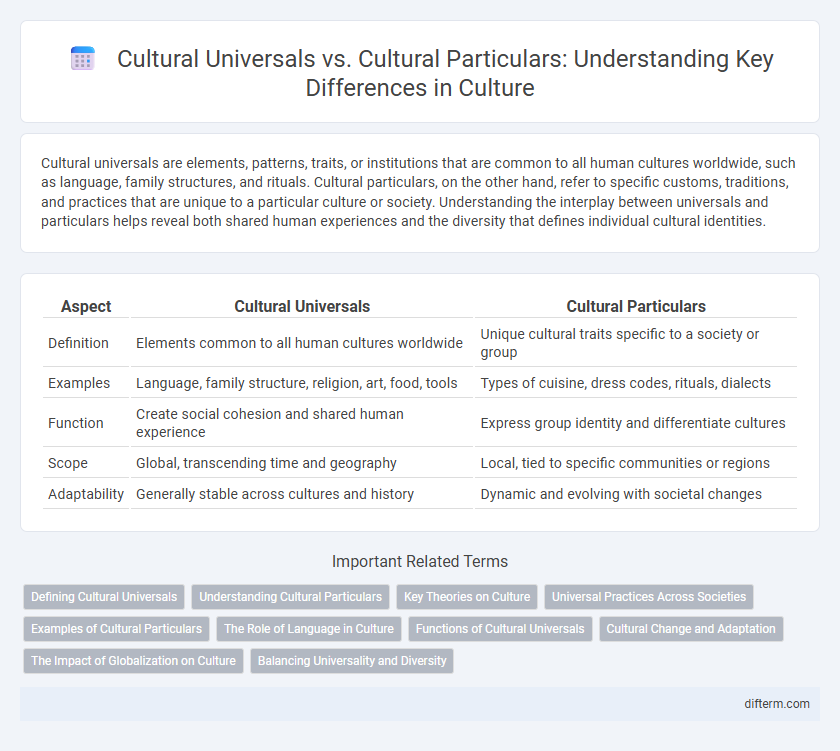Cultural universals are elements, patterns, traits, or institutions that are common to all human cultures worldwide, such as language, family structures, and rituals. Cultural particulars, on the other hand, refer to specific customs, traditions, and practices that are unique to a particular culture or society. Understanding the interplay between universals and particulars helps reveal both shared human experiences and the diversity that defines individual cultural identities.
Table of Comparison
| Aspect | Cultural Universals | Cultural Particulars |
|---|---|---|
| Definition | Elements common to all human cultures worldwide | Unique cultural traits specific to a society or group |
| Examples | Language, family structure, religion, art, food, tools | Types of cuisine, dress codes, rituals, dialects |
| Function | Create social cohesion and shared human experience | Express group identity and differentiate cultures |
| Scope | Global, transcending time and geography | Local, tied to specific communities or regions |
| Adaptability | Generally stable across cultures and history | Dynamic and evolving with societal changes |
Defining Cultural Universals
Cultural universals are elements, patterns, traits, or institutions that are common to all human cultures worldwide, such as language, family structures, and rituals. These universals provide a framework for understanding shared human experiences despite diverse cultural expressions. Identifying cultural universals helps anthropologists distinguish between innate human behaviors and culture-specific practices, highlighting the fundamental similarities underlying cultural diversity.
Understanding Cultural Particulars
Cultural particulars are specific customs, traditions, and practices unique to a particular society or group, reflecting local history, environment, and social structures. Understanding cultural particulars involves examining language, rituals, cuisine, and social norms that distinguish one culture from another. This detailed knowledge helps promote cross-cultural respect and effective communication in diverse global interactions.
Key Theories on Culture
Key theories on culture differentiate between cultural universals, which are traits or practices common to all human societies, and cultural particulars, which are unique customs or beliefs specific to a single culture. Anthropologist George Murdock cataloged numerous cultural universals such as language, family structures, and religious rituals, emphasizing their role in human social organization. In contrast, Clifford Geertz highlighted the significance of cultural particulars through interpretive anthropology, arguing that understanding local meanings and symbols is essential to grasp the complexity of culture.
Universal Practices Across Societies
Universal practices across societies include fundamental cultural elements such as language use, family structures, and religious rituals that manifest in diverse forms yet serve similar social functions worldwide. These cultural universals facilitate communication, social cohesion, and identity formation, reflecting shared human experiences despite varying cultural particulars. Understanding these universals aids anthropologists in identifying common patterns that underscore human adaptability and cultural evolution.
Examples of Cultural Particulars
Cultural particulars refer to unique practices, beliefs, or artifacts specific to a particular society or group, such as the Japanese tea ceremony, Maasai warrior rituals, or traditional dress like the Scottish kilt. These elements reflect localized traditions and values that distinguish one culture from another. Understanding cultural particulars highlights the diversity and richness within the broader concept of cultural universals.
The Role of Language in Culture
Language serves as a fundamental cultural universal, enabling communication, identity formation, and shared knowledge across diverse societies. Cultural particulars manifest in the unique expressions, dialects, and linguistic norms that distinguish one community from another. The interplay between universal linguistic functions and culture-specific language use shapes social cohesion and cultural transmission worldwide.
Functions of Cultural Universals
Cultural universals, such as language, art, and kinship systems, serve essential functions by promoting social cohesion, ensuring survival, and facilitating communication across diverse societies. These shared elements help maintain stability and continuity within cultures by addressing common human needs and challenges. While cultural particulars reflect unique customs, cultural universals underscore the underlying similarities that connect human experiences globally.
Cultural Change and Adaptation
Cultural universals, such as language, family structures, and rituals, provide a common framework across societies, while cultural particulars represent unique expressions shaped by specific historical and environmental contexts. Cultural change emerges from the dynamic interaction between these universals and particulars, driven by factors like technological innovation, globalization, and social movements. Adaptation occurs as societies selectively integrate external influences to maintain social coherence and address new challenges, ensuring cultural continuity amid evolving conditions.
The Impact of Globalization on Culture
Globalization accelerates the diffusion of cultural universals, such as language, technology, and social norms, fostering interconnectedness across diverse societies. However, cultural particulars, including unique traditions, rituals, and localized beliefs, face both challenges and opportunities as they adapt or resist external influences. The dynamic interplay between these universals and particulars shapes evolving cultural identities amid global integration.
Balancing Universality and Diversity
Cultural universals, such as language, rituals, and social norms, provide a shared foundation across human societies, while cultural particulars reflect unique traditions and practices shaped by specific histories and environments. Balancing universality and diversity involves recognizing common human experiences without erasing distinctive cultural identities. Emphasizing both promotes mutual respect and enriches global understanding in an increasingly interconnected world.
Cultural universals vs cultural particulars Infographic

 difterm.com
difterm.com